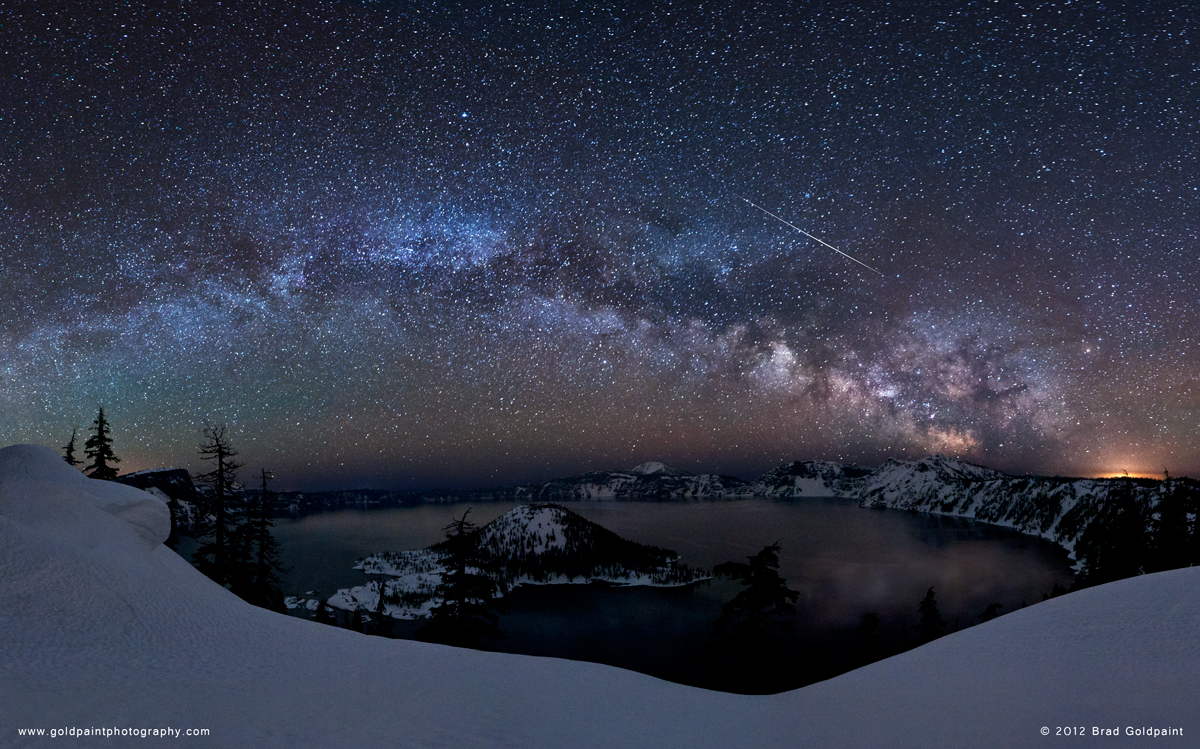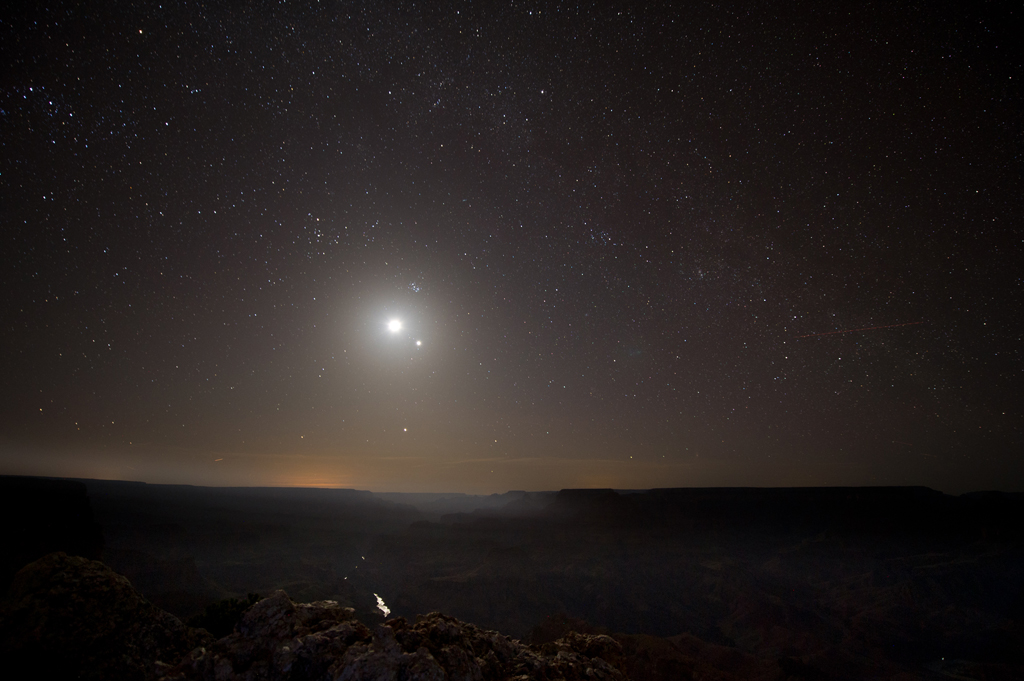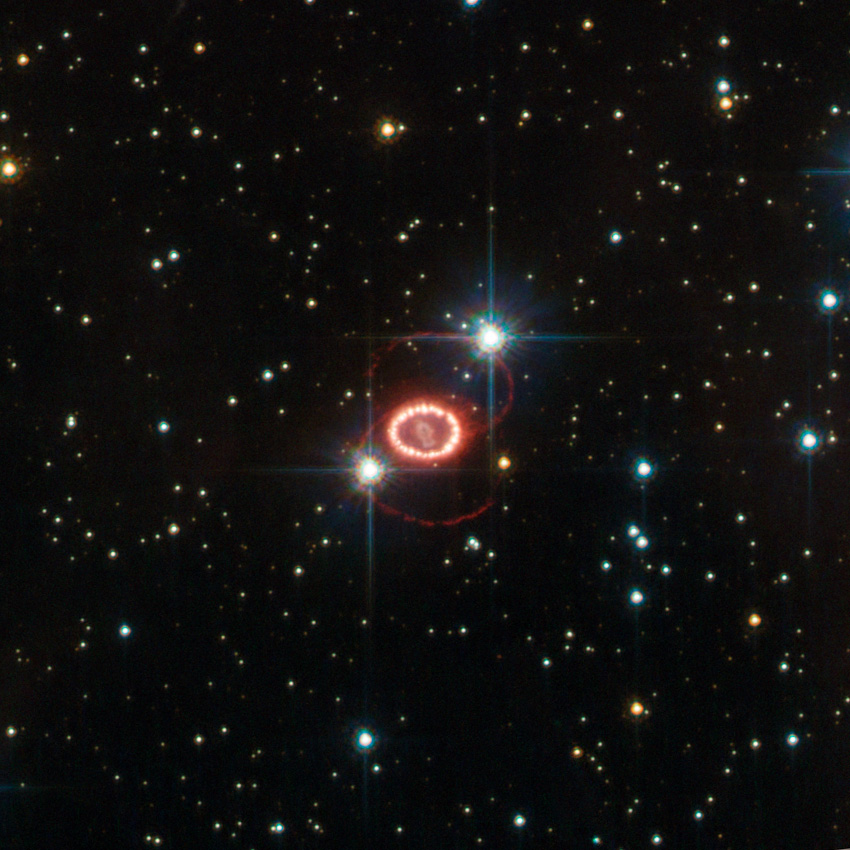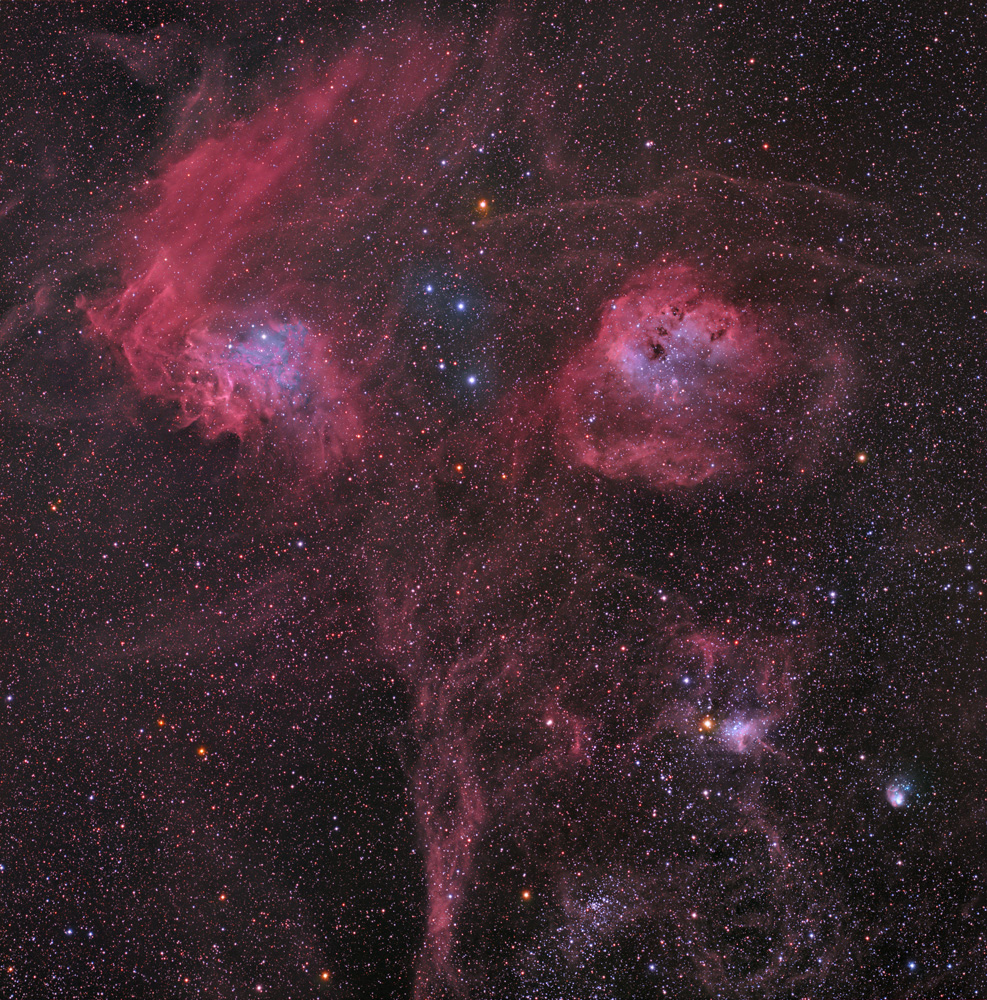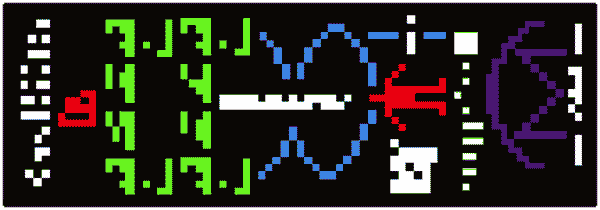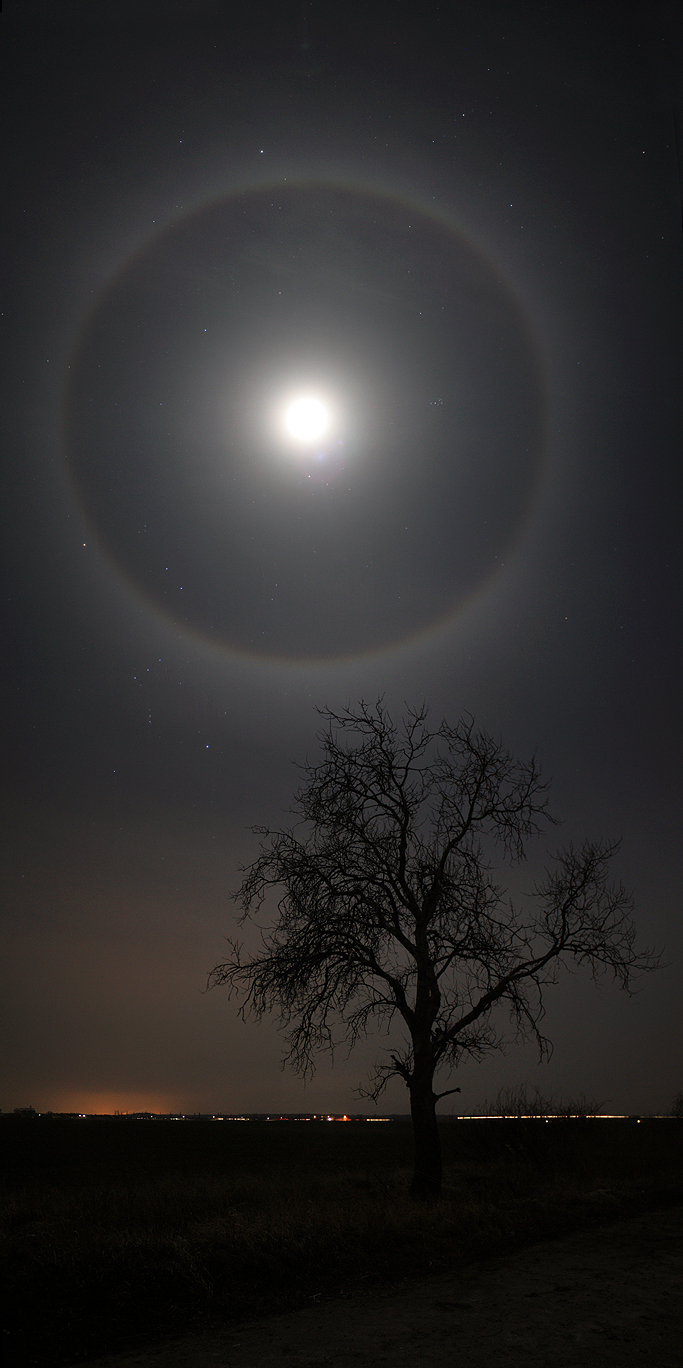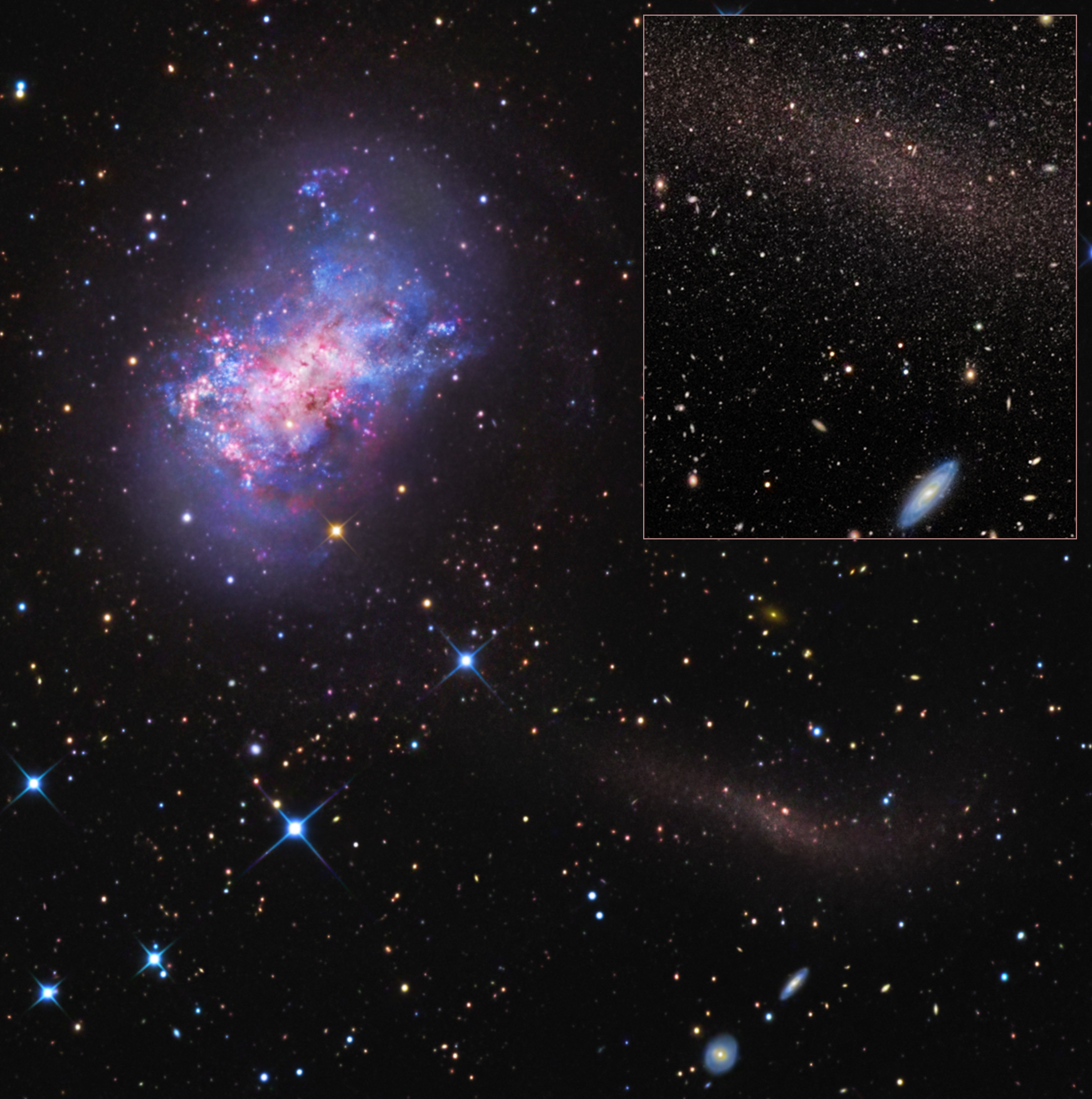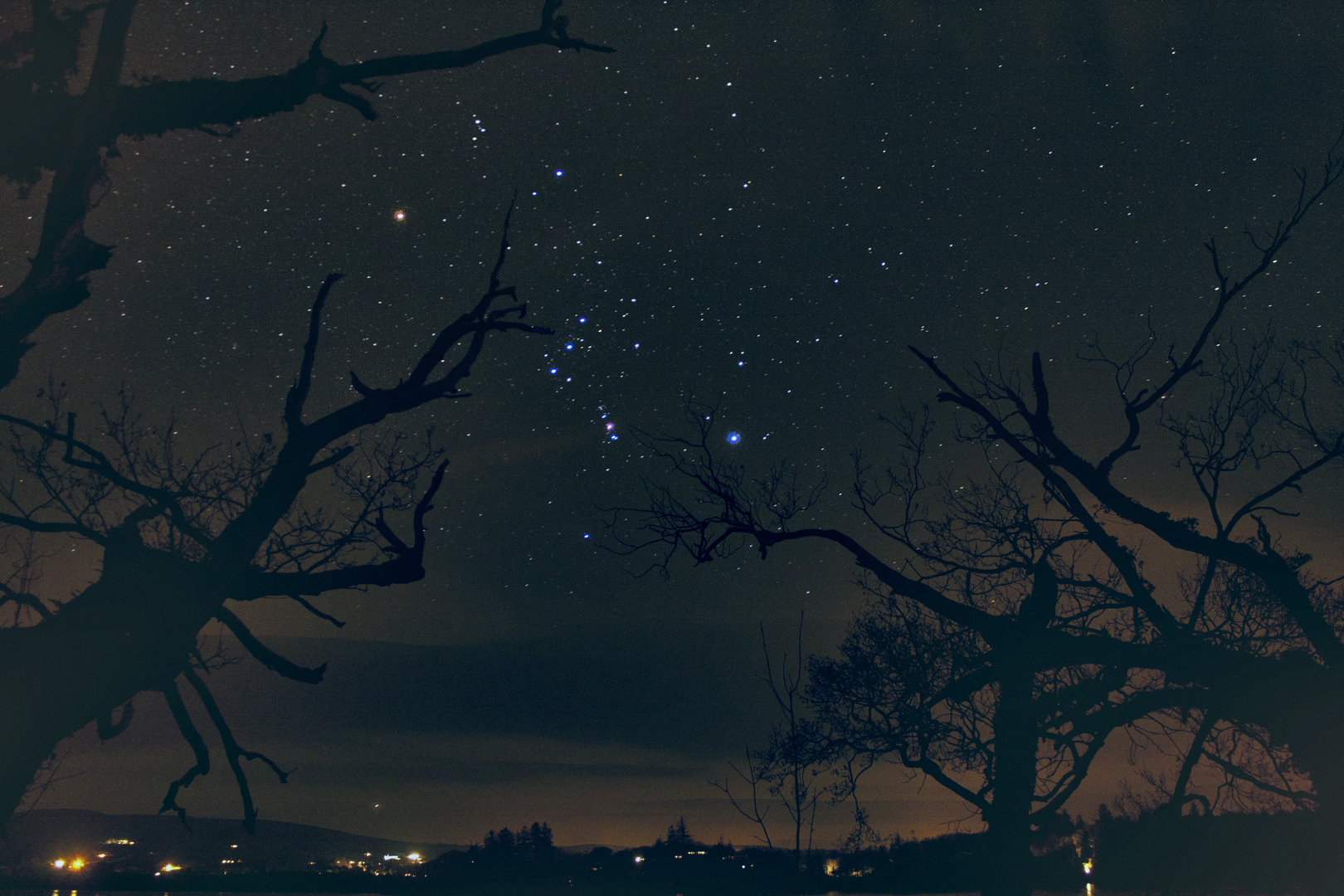Scorpius in Red and Blue
Cosmic dust clouds dim the light
of background stars.
But they also reflect the light of stars nearby.
Since bright stars tend to radiate strongly in the blue portion
of the visible spectrum, and the interstellar
dust
scatters blue light more
strongly than red, the dusty reflection nebulae tend to be blue.
Lovely examples are
the wispy blue reflection nebulae near bright, hot stars
Pi and Delta
Scorpii (upper left and lower right) in this
telescopic
skyscape from the head of the constellation Scorpius.
Of course, the contrasting red emission nebulae are also
caused by the hot stars' energetic radiation.
Ultraviolet photons ionize hydrogen atoms in the interstellar clouds
producing the characteristic
red hydrogen alpha emission line
as the electrons recombine.
About 600 light-years away, the nebulae are found in the second version of
the Sharpless
Catalog as Sh2-1 (left, with reflection nebulae VdB 99) and
Sh2-7.
At that distance, this field of view is about 40 light-years
across.
Friday, May 25, 2012
APOD 4.7 Herschel's Cygnus X
Herschel's Cygnus X
The Herschel Space Observatory's infrared view of Cygnus X spans some 6x2 degrees across one of the closest, massive star forming regions in the plane of our Milky Way galaxy. In fact, the rich stellar nursery already holds the massive star cluster known as the Cygnus OB2 association. But those stars are more evident by the region cleared by their energetic winds and radiation near the bottom center of this field, and are not detected by Herschel instruments operating at long infrared wavelengths. Herschel does reveal the region's complex filaments of cool gas and dust that lead to dense locations where new massive stars are forming. Cygnus X lies some 4500 light-years away toward the heart of the northern constellation of the Swan. At that distance this picture would be almost 500 light-years wide.
The Herschel Space Observatory's infrared view of Cygnus X spans some 6x2 degrees across one of the closest, massive star forming regions in the plane of our Milky Way galaxy. In fact, the rich stellar nursery already holds the massive star cluster known as the Cygnus OB2 association. But those stars are more evident by the region cleared by their energetic winds and radiation near the bottom center of this field, and are not detected by Herschel instruments operating at long infrared wavelengths. Herschel does reveal the region's complex filaments of cool gas and dust that lead to dense locations where new massive stars are forming. Cygnus X lies some 4500 light-years away toward the heart of the northern constellation of the Swan. At that distance this picture would be almost 500 light-years wide.
APOD 4.6 Shuttle Enterprise Over New York
Shuttle Enterprise Over New York
What's that in the background? Two famous New York City icons stand tall in the above photo taken last week. On the left looms the Statue of Liberty, a universal symbol of freedom, while on the right rises the Empire State Building, now the second largest building in the city. What's unique about this once-in-a-lifetime photograph, though, is the third icon that appears to Lady Liberty's left. High in the air and far in the background flies the space shuttle Enterprise -- perched atop a 747 jet -- on the way to its new home. New Yorkers and visitors to the Big Apple can visit the test space shuttle at the Intrepid Sea, Air & Space Museum on the West Side of Manhattan starting July 19.
What's that in the background? Two famous New York City icons stand tall in the above photo taken last week. On the left looms the Statue of Liberty, a universal symbol of freedom, while on the right rises the Empire State Building, now the second largest building in the city. What's unique about this once-in-a-lifetime photograph, though, is the third icon that appears to Lady Liberty's left. High in the air and far in the background flies the space shuttle Enterprise -- perched atop a 747 jet -- on the way to its new home. New Yorkers and visitors to the Big Apple can visit the test space shuttle at the Intrepid Sea, Air & Space Museum on the West Side of Manhattan starting July 19.
Wednesday, May 23, 2012
Gerard Kuiper
Biography of Gerard Kuiper
On
December 7, 1905 a small boy by the name of Gerrit Peter Kuiper was born in a
small town in the Netherlands called Tuitjenhorn. His father was a tailor, and
he himself was gifted with extraordinary eyesight that undoubtedly lead to his
early proficiencies in the field of astronomy. Kuiper’s interest in astronomy
would eventually lead him to make many discoveries including natural satellites,
atmospheres, and binary stars, and produce a theory later to be proved true of a
belt of comet-like debris existing in a ring just outside the solar system. All
together this information caused Kuiper to become an astronomer with influence
not limited to just his lifetime.
At
first little Gerrit, who later was called Gerard, focused on his basic interest
in the stars. This is not entirely surprising as he had eyesight that allowed
him to see stars with a magnitude of 7.5, essentially four times dimmer than
the average eye can see. By the time he reached the age of nineteen in 1924
Gerard began his studies with a number of other astronomers at Leiden
University. He graduated in 1927 and completed his doctorate work- fittingly on
binary stars- in 1933. At this time Kuiper moved to the United States and began
work as a fellow in California under Robert Grant Aiken at the Lick
Observatory. A few years later he left to work at the Harvard College
Observatory.
In 1935 while at this observatory, Kuiper met a young
woman by the name of Sarah
Parker Fuller. The next year, they were married. The real successes for Kuiper, regarding the field of astronomy, comes in the years to follow as he joins the Yerkes Observatory in 1937 at the University of Chicago. This same year Gerard Kuiper became a naturalized citizen. As an official Dutch-American astronomer Gerard Kuiper, now thirty two, began the bulk of his studies of the skies. In the time between his observing Kuiper found time to be a director of the observatory twice: once in 1947 and once in 1957. In 1944 he was focused more on planetary research and was able to confirm the presence of methane in the atmosphere of Titan, a moon of Saturn. By 1947 the interest in planets continued and Kuiper correctly predicted carbon dioxide as the main ingredient in the atmosphere of Mars, as well as the rings of Saturn being composed of ice particles. His research extended as far as Uranus, of which he discovered the fifth moon, Miranda. Over the next seven years Kuiper discovered Nereid orbiting Neptune, proved the polar ice caps on Mars are made of frozen water and not carbon dioxide, and proposed three major theories/predictions. The first of these was an influential new theory on the origins of the solar system. Kuiper proposed that the planets had formed from the condensation of a large cloud of gas surrounding the sun. In addition to this he predicted that the surface of the moon would be like ‘crunchy snow’ to walk on- verified later by Armstrong and his description of the moon’s surface. Two years after his solar system origin theory he suggested the presence of a disk-shaped region of minor planets outside the orbit of Neptune. While he was not able to confirm this during his life, it was in fact proven to be true twenty years after his death with the presence of what is today called the Kuiper Belt.
Parker Fuller. The next year, they were married. The real successes for Kuiper, regarding the field of astronomy, comes in the years to follow as he joins the Yerkes Observatory in 1937 at the University of Chicago. This same year Gerard Kuiper became a naturalized citizen. As an official Dutch-American astronomer Gerard Kuiper, now thirty two, began the bulk of his studies of the skies. In the time between his observing Kuiper found time to be a director of the observatory twice: once in 1947 and once in 1957. In 1944 he was focused more on planetary research and was able to confirm the presence of methane in the atmosphere of Titan, a moon of Saturn. By 1947 the interest in planets continued and Kuiper correctly predicted carbon dioxide as the main ingredient in the atmosphere of Mars, as well as the rings of Saturn being composed of ice particles. His research extended as far as Uranus, of which he discovered the fifth moon, Miranda. Over the next seven years Kuiper discovered Nereid orbiting Neptune, proved the polar ice caps on Mars are made of frozen water and not carbon dioxide, and proposed three major theories/predictions. The first of these was an influential new theory on the origins of the solar system. Kuiper proposed that the planets had formed from the condensation of a large cloud of gas surrounding the sun. In addition to this he predicted that the surface of the moon would be like ‘crunchy snow’ to walk on- verified later by Armstrong and his description of the moon’s surface. Two years after his solar system origin theory he suggested the presence of a disk-shaped region of minor planets outside the orbit of Neptune. While he was not able to confirm this during his life, it was in fact proven to be true twenty years after his death with the presence of what is today called the Kuiper Belt.
In 1960 Kuiper founded the Lunar and Planetary Laboratory
at the University of Arizona and was the director for the next thirteen years,
until his death in 1973. Kuiper died while on vacation with his wife, Sarah, in
Mexico. In his honor were named: The Kuiper Airborne Observatory, craters on
the moon, Mercury, and Mars, and the Kuiper belt itself- the most recognized of
his influences.
Wednesday, May 16, 2012
Biography Sources- Gerard Kuiper
http://solarsystem.nasa.gov/people/profile.cfm?Code=KuiperG
http://www.biography.com/people/gerard-kuiper-9369878
http://www.biography.com/people/gerard-kuiper-9369878
Friday, April 27, 2012
Observation Hours
Last night, April 26, I was outside for quite a few hours: from nine to two in the morning in Sarasota. Random, yes. Helpful, also yes. It was amazing because while lying outside I saw no less than six separate satellites going in all different directions. It was cool because they all looked like at some point they would have to cross paths with each other which naturally means they would crash, violently. Obviously this didn't happen because they are at different distances from the Earth. Thinking about this got me to think about that nifty little fact with the grain of sand- if you hold a grain of sand at arms length it covers in the sky approximately 3,000 galaxies. This fact then became even more awesome when we actually ended up at Siesta Key beach by midnight, and held up grains of sand. Very conceptual and extremely mind-blowing. The best part was probably Michael Everingham freaking out about not being able to pick up just one grain though... Back to astronomy. In the west in the early night I saw Orion easily with Rigel and Betelgeuse, and next to it was Canis Major. I like that because, since they are so easily identifiable, I could watch their slow descent towards the horizon and past the treeline. Katie McPartland and I picked out Arcturus towards the north, Sirius, Spica, Saturn, Mars, Venus and even Hydra's head which was interesting because I had never seen it before. Spica and Saturn were much closer to each other than I had expected. Throughout the course of the night we both saw meteorites, at least one each, and oddly enough were able to recognize the summer triangle! Did not see that coming. But we did, starting with Vega in Lyra, and leading down to the Northern Cross in Cygnus and Altair.
APOD 4.5 Meteor Over Crater Lake
Meteor Over Crater Lake
Did you see it? One of the more common questions during a meteor shower occurs because the time it takes for a meteor to flash is typically less than the time it takes for a head to turn. Possibly, though, the glory of seeing bright meteors shoot across and knowing that they were once small pebbles on another world might make it all worthwhile, even if your observing partner(s) could not share in every particular experience. Peaking over the past few days, a dark moonless sky allowed the Lyrids meteor shower to exhibit as many as 30 visible meteors per hour from some locations. A bright Lyrid meteor streaks above picturesque Crater Lake in Oregon, USA, in the above composite of nine exposures taken last week. Snow covers the foreground, while the majestic central band of our home galaxy arches well behind the serene lake. Other meteor showers this year include the Perseids in mid-August and the Leonids in mid-November, both expected to also dodge the glare of a bright Moon in 2012.
APOD 4.4 Discovery Departs
Discovery Departs
Climbing into cloudy skies, the Space Shuttle Orbiter Discovery (OV-103) took off from Kennedy Space Center Tuesday at 7 am local time. This time, its final departure from KSC, it rode atop a modified Boeing 747 Shuttle Carrier Aircraft. Following a farewell flyover of the Space Coast, Goddard Space Flight Center, and Washington DC, Discovery headed for Dulles International Airport in Virginia, destined to reside at the Smithsonian's National Air and Space Museum Udvar-Hazy Center. Discovery retires as NASA's most traveled shuttle orbiter, covering more than 148 million miles in 39 missions that included the delivery of the Hubble Space Telescope to orbit. Operational from 1984 through 2011, Discovery spent a total of one year in space.
APOD 4.3 A Dust Devil on Mars
A Dust Devil on Mars
Does this look like a random wall with spraypaint on it to anyone else? It was late in the northern martian spring when the HiRISE camera onboard the Mars Reconnaissance Orbiter spied this local denizen. Tracking south and east (down and right) across the flat, dust-covered Amazonis Planitia the core of the whirling dust devil is about 30 meters in diameter. Lofting dust into the thin martian atmosphere, its plume reaches more than 800 meters above the surface. Not following the path of the dust devil, the plume is blown toward the east by a westerly breeze. Common in this region, dust devils occur as the surface is heated by the Sun, generating warm, rising air currents that begin to rotate. Tangential wind speeds of up to 110 kilometers per hour are reported for dust devils in other HiRISE images.
Does this look like a random wall with spraypaint on it to anyone else? It was late in the northern martian spring when the HiRISE camera onboard the Mars Reconnaissance Orbiter spied this local denizen. Tracking south and east (down and right) across the flat, dust-covered Amazonis Planitia the core of the whirling dust devil is about 30 meters in diameter. Lofting dust into the thin martian atmosphere, its plume reaches more than 800 meters above the surface. Not following the path of the dust devil, the plume is blown toward the east by a westerly breeze. Common in this region, dust devils occur as the surface is heated by the Sun, generating warm, rising air currents that begin to rotate. Tangential wind speeds of up to 110 kilometers per hour are reported for dust devils in other HiRISE images.
APOD 4.1 The Grand Canyon in Moonlight
The Grand Canyon in Moonlight
In this alluring night skyscape recorded on March 26, a young Moon stands over the distant western horizon in conjunction with brilliant planet Venus. In the foreground, the Colorado River glistens in moonlight as it winds through the Grand Canyon, seen from the canyon's southern rim at Lipan Point. Of course, the Grand Canyon is known as one of the wonders of planet Earth. Carved by the river, the enormous fissure is about 270 miles (440 kilometers) long, up to 18 miles (30 kilometers) wide and approaches 1 mile (1.6 kilometers) deep. On this date, wonders of the night sky included the compact Pleiades and V-shaped Hyades star clusters poised just above the Moon. Bright planet Jupiter is below the closer Moon/Venus pairing, near the western horizon.
Friday, April 13, 2012
APOD 4.2 Venus and the Sisters
Venus and the Sisters
Admittedly once again, I was drawn to this image for visual purposes. I like how brilliantly the planet Venus shines and in addition how it is one of those things that even amateur stargazers such as myself can easily recognize. After wandering about as far from the Sun on the sky as Venus can get, the brilliant evening star crossed paths with the Pleiades star cluster earlier this week. The beautiful conjunction was enjoyed by skygazers around the world. Taken on April 2, this celestial group photo captures the view from Portal, Arizona, USA. Also known as the Seven Sisters, even the brighter naked-eye Pleiades stars are seen to be much fainter than Venus. And while Venus and the sisters do look star-crossed, their spiky appearance is the diffraction pattern caused by multiple leaves in the aperture of the telephoto lens. The last similar conjunction of Venus and Pleiades occurred nearly 8 years ago. As it did then, Venus will again move on to cross paths with the disk of the Sun in June.
Friday, March 2, 2012
Alvan G. Clark Biography
Macauley Cleary
Pd. 3, Astronomy
Percival
2 Mar 2012
Alvan G. Clark
Alvan G. Clark is a little-mentioned astronomer from the 1800s whose life accomplishments may be few in number, but are great in importance. While much of Clark’s accomplishments are because of his father’s work in the field of telescope making, he did take things to a new level, so to speak, innovation-wise. As far as a background goes Clark was born in Fall River, Massachusetts in 1832 and took his time rising to recognition in the field of American astronomy. He is most noted for his discovery of Sirius B and the refracting telescope with which he discovered it.
From the moment on July 10 in 1832 when Alvan G. Clark was born he was inadvertently being set up at every turn for a life in the field of astronomy. His father was a lens maker who turned to telescope making and was known for his impeccable work. Through this opportunity Clark was able to become an optician and also take up a career in the line of lens making work. By following in his father’s footsteps Clark lead his family to create two disks of glass that were 42 inches in diameter each to fulfill a contract they had with the University of South Carolina. Upon telling this story to a colleague Clark was overheard by a man named George Ellery Hale. Luckily enough Hale was interested in the lenses and was able to purchase them when the previous deal fell through. Hale used the lenses to create the Yerkes Observatory, still one of the largest refracting telescopes today. This achievement perfectly demonstrated both the quality of work and the capabilities of Clark at such an early date.
After this accomplishment Clark went on to take things not one, but multiple steps further than ever before. He was in Cambridgeport, Massachusetts on January 31, 1862 testing out a new refracting telescope when he unexpectedly saw a previously unidentified object. This object turned out to be what is now known as Sirius B, a dimmer version (magnitude 8) of the star Sirius located in Canis Major. In addition to this Sirius B, now labeled, was a different kind of star. It was a white dwarf. Up until this point a white dwarf star had not been found, nor had it been studied. Clark’s accidental find opened the astronomical world up to a myriad of new possibilities regarding this recently discovered type of star. The telescope that Clark used was 18 inches in diameter, smaller than many that he helped to create but still large enough to get the job done, and was a refracting telescope. Though Clark used the telescope in Massachusetts, it now resides at the landmark Dearborn Observatory of the Northwestern University in Evanston, Illinois. Alvan G. Clark’s contributions to astronomy seem minimal but in reality were necessary and long-lived as they are still in use today.
APOD 3.7 The Mysterious Rings of Supernova 1987A
The Mysterious Rings of Supernova 1987A
What's causing those odd rings in supernova 1987A? Twenty five years ago, in 1987, the brightest supernova in recent history was seen in the Large Magellanic Cloud. At the center of the above picture is an object central to the remains of the violent stellar explosion. Surrounding the center are curious outer rings appearing as a flattened figure 8. Although large telescopes including the Hubble Space Telescope monitor the curious rings every few years, their origin remains a mystery. Pictured above is a Hubble image of the SN1987A remnant taken last year. Speculation into the cause of the rings includes beamed jets emanating from an otherwise hidden neutron star left over from the supernova, and the interaction of the wind from the progenitor star with gas released before the explosion.
Monday, February 27, 2012
Bio Sources
http://www.nndb.com/people/702/000167201/
http://astro.uchicago.edu/yerkes/history/1892.html
http://astro.uchicago.edu/yerkes/history/1892.html
Friday, February 24, 2012
APOD 3.6 Aurigae Nebulae
Aurigae Nebulae
Rich in star clusters and nebulae, the ancient constellation of Auriga, the Charioteer, rides high in northern winter night skies. Composed from narrow and broadband filter data and spanning nearly 8 Full Moons (4 degrees) on the sky, this deep telescopic view recorded in January shows off some of Auriga's celestial bounty. The field includes emission region IC 405 (top left) about 1,500 light-years distant. Also known as the Flaming Star Nebula, its red, convoluted clouds of glowing hydrogen gas are energized by hot O-type star AE Aurigae. IC 410 (top right) is significantly more distant, some 12,000 light-years away. The star forming region is famous for its embedded young star cluster, NGC 1893, and tadpole-shaped clouds of dust and gas. IC 417 and NGC 1931 at the lower right, the Spider and the Fly, are also young star clusters embedded in natal clouds that lie far beyond IC 405. Star cluster NGC 1907 is near the bottom edge of the frame, just right of center. The crowded field of view looks along the plane of our Milky Way galaxy, near the direction of the galactic anticenter.
Rich in star clusters and nebulae, the ancient constellation of Auriga, the Charioteer, rides high in northern winter night skies. Composed from narrow and broadband filter data and spanning nearly 8 Full Moons (4 degrees) on the sky, this deep telescopic view recorded in January shows off some of Auriga's celestial bounty. The field includes emission region IC 405 (top left) about 1,500 light-years distant. Also known as the Flaming Star Nebula, its red, convoluted clouds of glowing hydrogen gas are energized by hot O-type star AE Aurigae. IC 410 (top right) is significantly more distant, some 12,000 light-years away. The star forming region is famous for its embedded young star cluster, NGC 1893, and tadpole-shaped clouds of dust and gas. IC 417 and NGC 1931 at the lower right, the Spider and the Fly, are also young star clusters embedded in natal clouds that lie far beyond IC 405. Star cluster NGC 1907 is near the bottom edge of the frame, just right of center. The crowded field of view looks along the plane of our Milky Way galaxy, near the direction of the galactic anticenter.
APOD 3.5 A Message From Earth
A Message From Earth
What are these Earthlings trying to tell us? The above message was broadcast from Earth towards the globular star cluster M13 in 1974. During the dedication of the Arecibo Observatory - still the largest single radio telescope in the world - a string of 1's and 0's representing the above diagram was sent. This attempt at extraterrestrial communication was mostly ceremonial - humanity regularly broadcasts radio and television signals out into space accidentally. Even were this message received, M13 is so far away we would have to wait almost 50,000 years to hear an answer. The above message gives a few simple facts about humanity and its knowledge: from left to right are numbers from one to ten, atoms including hydrogen and carbon, some interesting molecules, DNA, a human with description, basics of our Solar System, and basics of the sending telescope. Several searches for extraterrestrial intelligence are currently underway, including one where you can use your own home computer.
What are these Earthlings trying to tell us? The above message was broadcast from Earth towards the globular star cluster M13 in 1974. During the dedication of the Arecibo Observatory - still the largest single radio telescope in the world - a string of 1's and 0's representing the above diagram was sent. This attempt at extraterrestrial communication was mostly ceremonial - humanity regularly broadcasts radio and television signals out into space accidentally. Even were this message received, M13 is so far away we would have to wait almost 50,000 years to hear an answer. The above message gives a few simple facts about humanity and its knowledge: from left to right are numbers from one to ten, atoms including hydrogen and carbon, some interesting molecules, DNA, a human with description, basics of our Solar System, and basics of the sending telescope. Several searches for extraterrestrial intelligence are currently underway, including one where you can use your own home computer.
APOD 3.4 A February Moon's Halo
A February Moon's Halo
Lighting the night last Tuesday, February's Full Moon is sometimes called the Snow Moon. But the Moon was not quite full in this mosaicked skyscape recorded on February 2 south of Budapest, Hungary, and there was no snow either. Still, thin clouds of ice crystals hung in the cold, wintry sky creating this gorgeous lunar halo. Refraction of moonlight by the six-sided crystals produce the slightly colored halo with its characteristic radius of 22 degrees. Just below the Moon is bright star Aldebaran. Also well within the halo at the right is the Pleiades star cluster. At the lower left, near the halo's edge lie the stars of Orion with bright Capella, alpha star of the constellation Auriga, just beyond the halo near the top of the frame.
Lighting the night last Tuesday, February's Full Moon is sometimes called the Snow Moon. But the Moon was not quite full in this mosaicked skyscape recorded on February 2 south of Budapest, Hungary, and there was no snow either. Still, thin clouds of ice crystals hung in the cold, wintry sky creating this gorgeous lunar halo. Refraction of moonlight by the six-sided crystals produce the slightly colored halo with its characteristic radius of 22 degrees. Just below the Moon is bright star Aldebaran. Also well within the halo at the right is the Pleiades star cluster. At the lower left, near the halo's edge lie the stars of Orion with bright Capella, alpha star of the constellation Auriga, just beyond the halo near the top of the frame.
APOD 3.3 Red Aurora OVer Australia
Red Aurora over Australia
Aurora. Last week's solar storms, emanating mostly from active sunspot region 1402, showered particles on the Earth that excited oxygen atoms high in the Earth's atmosphere. As the excited element's electrons fell back to their ground state, they emitted a red glow. Were oxygen atoms lower in Earth's atmosphere excited, the glow would be predominantly green. Pictured above, this high red aurora is visible just above the horizon last week near Flinders, Victoria, Australia. The sky that night, however, also glowed with more familiar but more distant objects, including the central disk of our Milky Way Galaxy on the left, and the neighboring Large and Small Magellanic Cloud galaxies on the right. A time-lapse video highlighting auroras visible that night puts the picturesque scene in context. Why the sky did not also glow green remains unknown.
Aurora. Last week's solar storms, emanating mostly from active sunspot region 1402, showered particles on the Earth that excited oxygen atoms high in the Earth's atmosphere. As the excited element's electrons fell back to their ground state, they emitted a red glow. Were oxygen atoms lower in Earth's atmosphere excited, the glow would be predominantly green. Pictured above, this high red aurora is visible just above the horizon last week near Flinders, Victoria, Australia. The sky that night, however, also glowed with more familiar but more distant objects, including the central disk of our Milky Way Galaxy on the left, and the neighboring Large and Small Magellanic Cloud galaxies on the right. A time-lapse video highlighting auroras visible that night puts the picturesque scene in context. Why the sky did not also glow green remains unknown.
APOD 3.2 NGC 4449: Starstream
NGC 4449: Star Stream for a Dwarf Galaxy
A mere 12.5 million light-years from Earth, irregular dwarf galaxy NGC 4449 lies within the confines of Canes Venatici, the constellation of the Hunting Dogs. About the size of our Milky Way's satellite galaxy the Large Magellanic Cloud, NGC 4449 is undergoing an intense episode of star formation, evidenced by its wealth of young blue star clusters, pinkish star forming regions, and obscuring dust clouds in this deep color portrait. It also holds the distinction of being the first dwarf galaxy with an identified tidal star stream, faintly seen at the lower right. Placing your cursor over the image reveals an inset of the stream resolved into red giant stars. The star stream represents the remains of a still smaller infalling satellite galaxy, disrupted by gravitational forces and destined to merge with NGC 4449. With relatively few stars, small galaxies are thought to possess extensive dark matter halos. But since dark matter interacts gravitationally, these observations offer a chance to examine the significant role of dark matter in galactic merger events. The interaction is likely responsible for NGC 4449's burst of star formation and offers a tantalizing insight into how even small galaxies are assembled over time.
Wednesday, February 22, 2012
How stars form
Star formation occurs when clouds of gas, molecular clouds, form within galaxies. Slight structures form within the clouds and some, once they are dense enough, collapse under their own weight to form disks with what is known as a protostar in the center. Dust and gas begin to be pushed away from the recently formed disk in the form of bipolar outflows- the pushing away because of energy from the clouds' falling and from recently formed stars' wind. The protostar then gathers the materials that are not being lost to the disk via the outflow, and grows. The protostar starts to undergo fusion and at that point is considered a full star, even with its continued growth. This process is referred to as gravitational collapse. There is also another method known as competitive accretion in which the stars start out small and grow by accreting material from close clouds of gas and occasionally colliding with one another.
http://www.gps.caltech.edu/~gab/astrophysics/starformation_mccaughrean.gif
http://www.physicsoftheuniverse.com/images/bigbang_star_formation.jpg
http://www.aerospaceweb.org/question/astronomy/solar-system/formation.jpg
Friday, January 20, 2012
APOD 3.1 The Hunter's Stars
The Hunter's Stars
This image was interesting to me because of a) its recognizable-ness, and b) because you can actually see the colors of the different stars. Most times it seems as if the stars in the sky all have the same whitish, yellowed hue even though in reality they can be red or blue as well. In the constellation Orion there are a red and a blue star, named Betelgeuse and Rigel respectively. Betelgeuse is a red giant star and Rigel is a a blue supergiant- making it seem even more incredible to be able to determine their colors with the naked eye. What appears to be another star here is the light red glow in Orion's belt. This 'star' is actually the Orion nebula and is also seen easily with the naked eye. So overall this picture is not incredibly fascinating by itself, but the concept behind the subject matter is.
This image was interesting to me because of a) its recognizable-ness, and b) because you can actually see the colors of the different stars. Most times it seems as if the stars in the sky all have the same whitish, yellowed hue even though in reality they can be red or blue as well. In the constellation Orion there are a red and a blue star, named Betelgeuse and Rigel respectively. Betelgeuse is a red giant star and Rigel is a a blue supergiant- making it seem even more incredible to be able to determine their colors with the naked eye. What appears to be another star here is the light red glow in Orion's belt. This 'star' is actually the Orion nebula and is also seen easily with the naked eye. So overall this picture is not incredibly fascinating by itself, but the concept behind the subject matter is.
Friday, January 13, 2012
Observation 1
For purposes of this observation set I'm posting the total hours in one chunk post.
I tried something different this time and instead of just testing my locating and labeling abilities I went out for a few hours each night for three nights in a row to see if I could personally note the changes and movement of the stars in relation to the moon, as well as the moon's phases.
The first night I went out, at my house in Sarasota, beginning around one thirty in the morning. I was able to see the moon a few days before full and I made note of Pisces and Orion almost at the highest point in the sky, with Ursa Major to the north (obviously) handle pointed to the northeast, and Polaris not visible because of the light from the moon. To the northwest I also made a note of the Hyades, but mostly just because I like them.
The second night was slightly clearer to start but clouds rolled in before I was able to make a longer-lasting comparison. Before they reached full cover I did see Pisces and Pisces Austrinus move westward slightly, with Orion right behind them. The moon was close to Orion's belt and was slowly making its way into Pisces with a day before it was due to be full.
By the third night the moon was full and the sky was clear of any clouds or fog, a good sign. Though its brightness did obscure some of Pisces, Pisces Austrinus helped my identify its location west of the zenith point, and the belt of Orion lead me to his shoulders and head- also moved westward yet again. The Hyades were so small they were hard to make note of as far as shifting is concerned, but like I said, I just like them. The north star was barely visible, and even then only because the handle of the Big Dipper had rotated in its circumpolar manner to point it out to me more easily than on the slightly clouded first night. Oh, this night I also found Arcturus by myself for the first time, mainly because of the handle of Ursa Major as well.
I tried something different this time and instead of just testing my locating and labeling abilities I went out for a few hours each night for three nights in a row to see if I could personally note the changes and movement of the stars in relation to the moon, as well as the moon's phases.
The first night I went out, at my house in Sarasota, beginning around one thirty in the morning. I was able to see the moon a few days before full and I made note of Pisces and Orion almost at the highest point in the sky, with Ursa Major to the north (obviously) handle pointed to the northeast, and Polaris not visible because of the light from the moon. To the northwest I also made a note of the Hyades, but mostly just because I like them.
The second night was slightly clearer to start but clouds rolled in before I was able to make a longer-lasting comparison. Before they reached full cover I did see Pisces and Pisces Austrinus move westward slightly, with Orion right behind them. The moon was close to Orion's belt and was slowly making its way into Pisces with a day before it was due to be full.
By the third night the moon was full and the sky was clear of any clouds or fog, a good sign. Though its brightness did obscure some of Pisces, Pisces Austrinus helped my identify its location west of the zenith point, and the belt of Orion lead me to his shoulders and head- also moved westward yet again. The Hyades were so small they were hard to make note of as far as shifting is concerned, but like I said, I just like them. The north star was barely visible, and even then only because the handle of the Big Dipper had rotated in its circumpolar manner to point it out to me more easily than on the slightly clouded first night. Oh, this night I also found Arcturus by myself for the first time, mainly because of the handle of Ursa Major as well.
APOD 2.8 The Umbra of Earth
The Umbra of Earth
It doesn't seem like such an amazing thing at first glance, I mean there are overlapped images of the moon, and some are darker because of shadows, and they look almost like eclipsed or partially full moons. But if you really sit down to think about it this is incredible. We can see the shadow of the Earth. The shadow of the Earth. An entire planet. Technically speaking this image is only the umbra, or the darker and inner shadow of the Earth. The cross section that is visible is seen most easily during a lunar eclipse, which is why these images work so well together to demonstrate the concept of Earth having not only a shadow, but a recognizable shadow we can see while on the Earth itself.
APOD 2.7 Eclipsed Moon in the Morning
Eclipsed Moon in the Morning
This image, taken in Iran, shows the very beginnings of a lunar eclipse to happen on December 10. The excitement in seeing a total lunar eclipse is almost palpable in the astronomical community in the days leading up to the eclipse, particularly in areas where the eclipse will be fully viewable. What many people don't realize is that, as seen here, the moon and in so the eclipse are both visible in the early morning as well as night so even if you are not able to see the full eclipse from your location, the chances are that you will at least be able to see part of it at some point. There's a sort of rugged beauty that this picture captures, much like that of the moon, that is all too often overlooked.
APOD 2.6 Light Echos from V838 Mon
Light Echos from V838 Mon
Pardon my frankness, but at first glance this image of the light echo expanding out from the light flash of V838 Mon looks like a danish. A cherry danish. Admittedly this echo is much more complicated, starting with the great expansion of V838 Mon in 2002, and then suddenly fading again. And in addition a stellar flash like that of V838 Mon had never been seen before so there was nothing to compare the event to for researching opportunities. All that is currently known is that this light echo, about three light-years in diameter, is light from the flash reflected in rings by the interstellar dust surrounding the star.
Pardon my frankness, but at first glance this image of the light echo expanding out from the light flash of V838 Mon looks like a danish. A cherry danish. Admittedly this echo is much more complicated, starting with the great expansion of V838 Mon in 2002, and then suddenly fading again. And in addition a stellar flash like that of V838 Mon had never been seen before so there was nothing to compare the event to for researching opportunities. All that is currently known is that this light echo, about three light-years in diameter, is light from the flash reflected in rings by the interstellar dust surrounding the star.
APOD 2.5 Young Moon Meets Evening Star
Young Moon Meets Evening Star
People always say that astronomy is something that everybody can do, that it's simple and if you put even minimal effort into it you can get amazing results and knowledge. That idea is what I like about this week's APOD. You can see the moon barely into its second day as a waxing crescent, and the current evening star Venus which at this point has just replaced Mercury in visibility. The information section of this APOD isn't exactly bursting with news, but this day has other importance. Anyone from anywhere in the world, given clear skies, could have seen this this night. I know I did, and just knowing that we are able to look upon the same sight as those in northern Portugal, from where this image was taken, is enough learning for one day.
People always say that astronomy is something that everybody can do, that it's simple and if you put even minimal effort into it you can get amazing results and knowledge. That idea is what I like about this week's APOD. You can see the moon barely into its second day as a waxing crescent, and the current evening star Venus which at this point has just replaced Mercury in visibility. The information section of this APOD isn't exactly bursting with news, but this day has other importance. Anyone from anywhere in the world, given clear skies, could have seen this this night. I know I did, and just knowing that we are able to look upon the same sight as those in northern Portugal, from where this image was taken, is enough learning for one day.
APOD 2.4 Pelican Nebula Close-Up
Pelican Nebula Close-Up
The Pelican Nebula that is in this APOD spans thirty light-years and is in the constellation Cygnus. While it is fascinating, I did not choose this APOD because of the fact that it covers the Pelican Nebula so much as how it covers it. The picture shown is in full color, and is gorgeous. The thing is that the Pelican Nebula does not look like this if one focuses in on it in the night sky. The colors were 'translated' into colors in the visible light spectrum for comprehension purposes. On top of this it is named the Pelican Nebula. Maybe it's just me, but I have a hard enough time seeing Cygnus as a swan let alone seeing the pelican in this nebula. So to me this is extremely misrepresented both in name and in the visual aspect. It just kind of shows how, while stunning conceptually and visually, certain parts of astronomy are just not along a logical sequence.
The Pelican Nebula that is in this APOD spans thirty light-years and is in the constellation Cygnus. While it is fascinating, I did not choose this APOD because of the fact that it covers the Pelican Nebula so much as how it covers it. The picture shown is in full color, and is gorgeous. The thing is that the Pelican Nebula does not look like this if one focuses in on it in the night sky. The colors were 'translated' into colors in the visible light spectrum for comprehension purposes. On top of this it is named the Pelican Nebula. Maybe it's just me, but I have a hard enough time seeing Cygnus as a swan let alone seeing the pelican in this nebula. So to me this is extremely misrepresented both in name and in the visual aspect. It just kind of shows how, while stunning conceptually and visually, certain parts of astronomy are just not along a logical sequence.
APOD 2.3 The View From Chajnantor
The View From Chajnantor
When I first saw this image I didn't realize how wide the image was, so I only saw about the farthest left third of the picture. Even though I only saw a piece of it though it reminded me of the technique we recently studied where you use multiple satellites to gather bits of data and then combine them later to get the full picture, so to speak. This particular array, the Atacama Large Millimeter/submillimeter Array, gathers information from wavelengths over 1,000 times the length of visible light. What made this even more incredible to me was that we had just covered this technique in class, and seeing this example and full image of the array in action really solidified the concept for me in more than a hypothetical way.
When I first saw this image I didn't realize how wide the image was, so I only saw about the farthest left third of the picture. Even though I only saw a piece of it though it reminded me of the technique we recently studied where you use multiple satellites to gather bits of data and then combine them later to get the full picture, so to speak. This particular array, the Atacama Large Millimeter/submillimeter Array, gathers information from wavelengths over 1,000 times the length of visible light. What made this even more incredible to me was that we had just covered this technique in class, and seeing this example and full image of the array in action really solidified the concept for me in more than a hypothetical way.
Thursday, January 12, 2012
Giuseppe Piazzi
Macauley Cleary
Astronomy, Pd. 3
Mr. Percival
12 Jan 2012
Giuseppe Piazzi
On July 16, 1746 the astronomical community received what was to be one of the most productive minds for the next eighty years. Giuseppe Piazzi was born in Ponte in Valtellina, and from the start had a mind eager for knowledge. There is no specific account of his education, but it is known that he studied in Milan, Turin, Rome, and Genoa respectively. Throughout his life Piazzi held many roles, his most familiar being those of student as well as teacher. Though his travels were extremely educational, they also presented opportunities not confined to just learning. Piazzi was involved in the start and completion of quite a few observatories and in addition received varying titles along the way. Through these observatories and personal observations he compiled and revised lists and catalogues of stars. What is by far his most notable accomplishment, however, is his observing and labeling of the asteroid Ceres- the largest asteroid and only known dwarf planet in the solar system.
At the start of his instructive position in July 1770, Piazzi took the chair of mathematics at the University of Malta. After some time in that job he moved on to Ravenna where he chose to lecture in philosophy and mathematics, and from there to a longer stay in Palermo. It was at the University of Palermo that the magic happened, so to speak. Piazzi started out as a mathematics teacher again, but then became the professor of Astronomy on January 19, 1787- the move that kick started his astronomical career. While acting as the professor of Astronomy Giuseppe Piazzi was given two years to study abroad and train in the field of astronomy, and to gather instruments for the new Palermo Observatory. Because he was placed in charge of the foundation of this observatory Piazzi was able to obtain the altazimuth circle along with other specialized tools for the observatory’s use. During these travels to Paris and London he was able to study with top astronomers of the time and learn the ins and outs of the astronomical community.
The access granted to Giuseppe Piazzi through the Palermo Observatory allowed for him to oversee and take part in the compilation of many lists. These included accounts of exacts positions of the stars and revisions of older catalogues. By 1803 he published a list of almost seven thousand stars and roughly ten years later a second catalogue of near eight thousand. While making these notes Piazzi observed a peculiar star that he at first thought to be like any other, but after four nights was able to confirm that it did in fact move and therefore could not be a star. He was apprehensive at first and took the cautious route of labeling the ‘star’ as a comet. Though he believed that this object was a planet Piazzi did not think it a good idea to release this idea to the public and so he stuck with his label of a comet. Unfortunately Giuseppe Piazzi was not able to observe this object for very long because of the orbit it took and the glare of the sun, but he did decide to call it Ceres Ferdinandea, after a King Ferdinand- the latter half of which was later dropped because of political reasons. Ceres is now known as the first and largest asteroid in the asteroid belt, and a dwarf planet.
However, for Piazzi the opportunities did not stop there. It was almost thirty years later that King Ferdinand decided to put Giuseppe Piazzi in charge of the completion of the Capodimonte Observatory. The King also named him the General Director of the Naples and Sicily Observatories, giving him more than enough access to pursue his true passion for the stars.
Subscribe to:
Posts (Atom)



